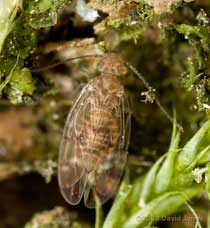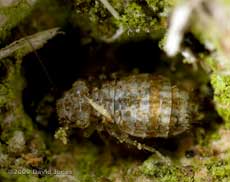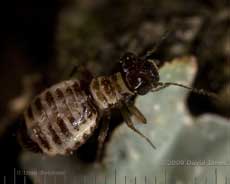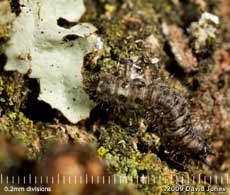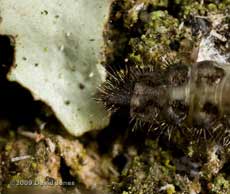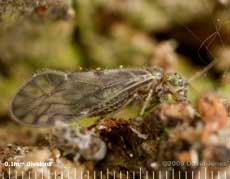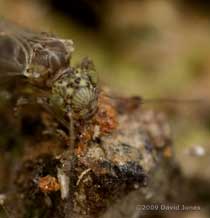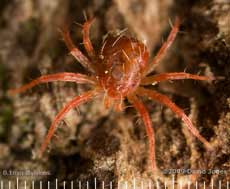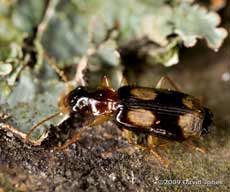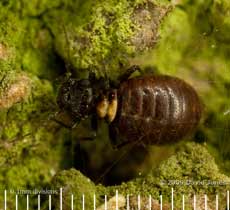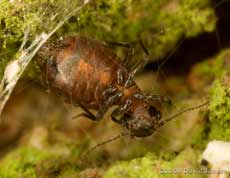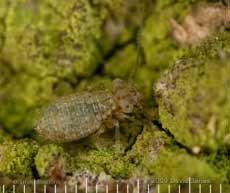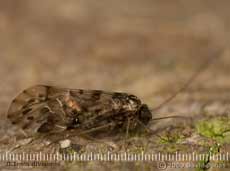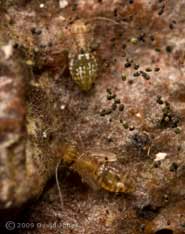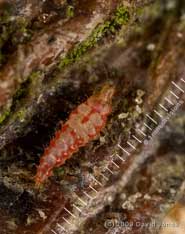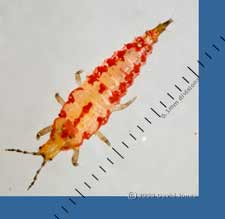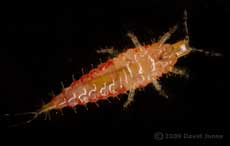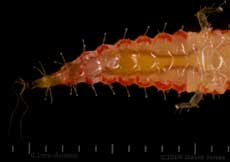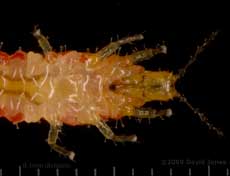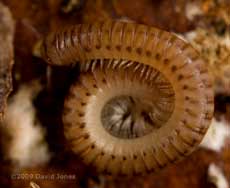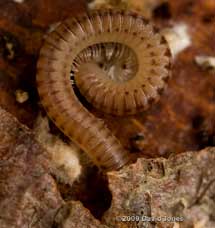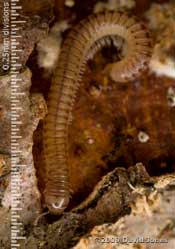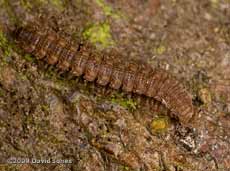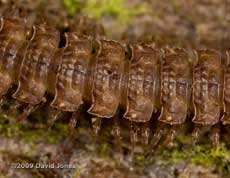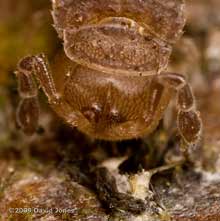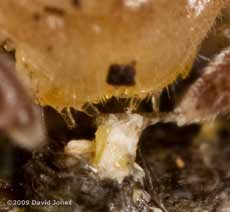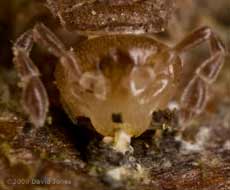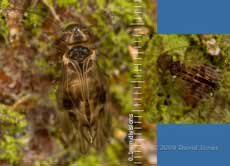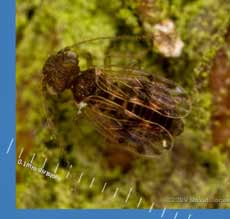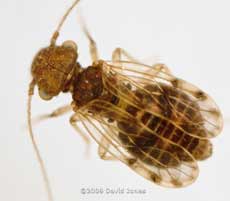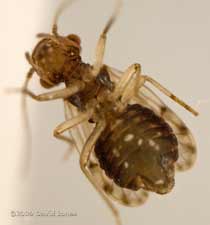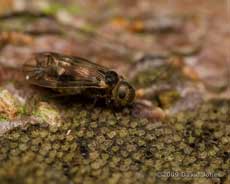Go to the last entry on this page .....Go to previous entry18 September - We have made it to the end of the second week of work on our hallway. Even though I'm not involved (apart from coffee making!), I'm looking forward to a weekend break! Hopefully it will be completed next week (apart from carpet fitting, and a door that has to be ordered after the carpet is in place). I'm not been doing anything in the garden over the last few days. Yesterday I collected a few Oak logs from my tree surgeon son. They came from one of two Oaks that he had to fell in the last week and they've given me an opportunity to go on a successful barkfly hunt on my dining room table!
First, Ectopsocus briggsi, a common species that I've found in the garden. Inspecting six logs, I came up with just two examples of these.
Next is Cerobasis questfalica. Although this is described as a common species, I have not come across it in the garden, and its distribution seems to be biased towards the north. Again, I've only found a couple on the logs checked so far, this one tucked away in a crack and the other dashing about, giving me quite a challenge while using 5X magnification.
The third species is a very welcome find - Pseudopsocus rostocki. This is the rare species that I mentioned last week and first found on Oak logs back in November last year. This time I found not one but five individuals on two of the logs. Having said that, for much of the time they were hidden either in cracks or under the lobes of lichen that cover some of the bark. I will take some photographs of the lichens and algae in the days to come.
And finally another insect type, at least a beetle larva (unidentified) - I found five of these on the logs. This one was the only one on the move,
and it was interesting to note that it was feeding on lichen.
There are two large pile of logs (the two Oaks) in my son's garden, and I hope to inspect a lot more of them as soon as I can.
19 September - a warm, sunny day - back into shorts! And we didn't get any of the rain that was threatened for late in the day. I spent much of the day doing some woodwork as part of the work on our hallway, but this evening I took another look at a couple of the logs from yesterday. I didn't see any of the barkflies that I photographed then but I did come across another species.
It is Philotarsus parviceps, another common species, although I've come across it just twice before on logs brought to the garden, both times in mid-October.
This one decided to graze while I watched, although I couldn't quite decide what it was eating. I need to take another look at that bit of the log.
And two creatures that didn't show themselves the first time that I looked at the logs.
First, this relatively large red mite that moved quickly across open spaces, pausing just long enough for me to grab a couple of pictures. There are some much smaller mites of at least two different species on the logs and I'll be taking photographs of these at some point.
The second surprise was this beetle that must have been hidden in one of the deep splits in the log. I didn't record a scale at the time, but it is about 6mm long and is Dromius quadrimaculatus
20 September - Another dry day, and although it wasn't as warm as yesterday it was still a case of shorts order! No photographs today, but there is an update on yesterday's entry. A thanks to Susan and Steve McManus for identifying the beetle as Dromius quadrimaculatus, a Ground Beetle that is common in the UK and is also in one of my insect guides! Late this afternoon I collected some more oak logs to check out, so I hope to come up with some more related pictures over the next few days. I haven't mentioned 'our' fox recently. If I relied on the cctv images, the lack of night-time activity would tempt me to say that it has definitely left the garden. However, two days ago I had to get a piece of timber from the shelter and I disturbed the fox, which climbed up onto the shelter roof, trotted over my head, over the log store and into my neighbour's garden. Yesterday afternoon I saw sorting something out behind the caravan when I heard footsteps above me again. This time it was not in a rush but had obviously been enjoying the afternoon sunshine. I watched as it jumped down onto the shed before heading into my other neighbour's garden.
21 September - a bright, sunny, and very pleasant Autumn day.
I've started looking at more logs from the same Oak tree, and as soon as I started on the second log examined I found another 'normal' P. rostocki. However, I ignored that when, under silk and just a centimetre away I spotted this individual. It's shape suggests that it is also P. rostocki, but with a very different colour scheme. I think I need to seek Bob Saville's advice on this one! Is is simply a colour variant? It is rather small.
Looking at my copy of Booklice and Barklice by R. R. New, I'm beginning to wonder if it is in fact a different species, Reuterella helvimacula. If so, then the absence of wings (apterous) would indicate that this is a female, as the males have wings (macropterous). Interestingly, while the book says that the body is dark brown, photographs on Bob's National Barkfly Recording Scheme website show the abdomen as predominantly pale, with thin dark bands. Well, Bob's first response has me waiting with some anticipation! He cannot find records of colour variation on P. rostocki and has mentioned two other possibilities. The first is a species that has only one previous record in the UK, in Northumberland in 1893 , and the other is a European species which is unknown in Britain. Anyway, it's too soon to get excited. Once I've taken some more photographs for my records the barkfly will be in its way, first to Bob in Edinburgh and then probably on to Geneva, Switzerland...
Anyway, in the identification of insects (and spiders) a microscopic examination of the genital areas is often essential to distinguish between similar species. While I'm not equipped for that, I did manage to grab this picture of the underside of the barkfly as it worked on its silk canopy.
Getting back to earth with a common species, another picture of Cerobasis questfalica, this one clearly a nymph. It was feeding on the algae. There were several of this species on the same log as the unknown barkfly.
26 September - Our 'Indian Summer' goes on with yet another nice day, although it does get chilly in the shade despite the sunshine. The lack of rain means that this evening I needed to top up the big pond quite a bit - there was no water in at the shallow end! I've had little time to enjoy the sunshine out in the garden, but it has brought out Speckled Wood butterflies to sunbathe along the path. A follow up from the previous entry - The unknown barkfly was sent to Edinburgh (along with a couple of Pseudopsocus rostocki). Bob soon e-mailed me with the news that rather than the brown barkfly being one of the possibilities that he had considered, it was in fact what I had suggested in my entry, namely Reuterella helvimacula. It was a colour variant that he had not seen before. It may not have been a 'super rare' species, but it was still a first for me! Work is still in progress in our hallway and it has meant that I have not had the opportunity to do anything with the Oak logs over the last few days. However, I did take a look at one this evening and was rewarded with yet another 'new' barkfly. I'm certain that this one is Trichadenotecnum sexpunctatum, a large barkfly (this one is around 4.3mm long) with long antennae. It is a widely distributed but uncommon species in Britain. With the weather remaining dry I've been a bit concerned that the bark on the logs may be drying out, so each evening I've been spraying them with rain water from a butt.
28 September - Not so sunny this morning, but it turned into another bright day with a red sky at sunset.
With just a few more days to go for the work in our hallway, it's difficult to get too involved with photography. However, I did take a look at a couple of logs from an apple tree that was felled locally. There was plenty of silk with barkfly droppings attached, and there were numerous barkfly nymphs on them. I couldn't see any adults today, but I'll look again tomorrow.
I would probably have spent longer looking for adults if I hadn't been distracted by a colourful, if intriguing insect on a decaying portion of one of the logs. Its colouring made it stand out despite its diminutive size of around 1.6mm.
I'm at a bit of a loss with this one. Is it a nymph, or a member of one of the primitive insect groups?
And a view of its underside.
Seen against a dark background you can see that the hairs on its body and limbs have swollen ends. Notice the change in colouring between thorax and abdomen.
This picture suggests that there is a proboscis type arrangement for feeding rather than jaws.
In an e-mail, Tom Ward has suggested that it matches the general description of a Thrip. This certainly looks possible. It could be a larva or a wingless adult. A search of the web seems to reinforce this suggestion, and the shape seems to match that of a second instar larva.
29 September - A bit more cloud today although the afternoon was sunny, with a high just below 20C. I had another look at the apple logs this morning and this time I did find adult barkflies, all of which were Peripsocus milleri. No pictures of them today as they seemed very wary about any movements made close to them. They usually dashed off to hide under the paper thin bark wherever it was flaking off the log. I think that all the nymphs I've been seeing must be that same species. The thin spaces under that bark also provides shelter (and darkness) for other creatures and this morning I came across two, both millipedes.
This one was curled up when I peeled back a bit of bark.
Immediately, it headed into the nearest dark space, but
peeling back a bit more bark gave me just one more photo-opportunity before it hid itself away again. As for its identity - I'm unsure and I will need to investigate further. There are nearly 50 different species in the UK but my guides only show five!
The second millipede I can identify as Polydesmus angustus, a species that is found in leaf litter, compost heaps as well as under the bark of rotting logs.
At first glance it looks like a centipede, but a closer look confirms that most of its body segments have two pairs of legs.
Unlike the first millipede, this individual didn't head straight for cover but wandered over the bark for a while, using its antennae to tab at the bark in front of it.
Then, it seemed to find something worthy of tasting. It probed with structures that I have yet to find named in descriptions of millipede morphology.
That test having proved satisfactory it was then a matter of biting!
30 September - The month has ended on a cloudy note, with just a few drops of rain during the late morning but which came to nothing. For us the month comes to a close accompanied by the aroma of drying paint as the work on our hallway reaches its final few days. And to close the month another entry dedicated to barkflies -
On the left is a very familiar Peripsocus milleri. There were numerous of this species on one of the logs. Measuring some 2.3mm it is almost twice the length of the other species (shown on the right) that was also present.
At 1.3mm in length, the wing markings suggest that this barkfly is likely to be Ectopsocus petersi although it appears quite a bit darker than previous examples of this species that I've seen.
I decided to take a closer look, and brought it indoors to take the following pictures. I have lightened the images slightly in an attempt to bring out more of the details.
It didn't appreciate it when the glass it was perched on was turned upside-down to get a ventral view. It didn't fall off the glass, but walked quickly to the side of the container each time I tried, so pictures had to be taken quickly as it moved. Looking at the genital details at the rear of the abdomen (and matching them with drawings on my copy of 'Booklice and barklice' by T.R. New) hasn't helped my to confirm the ID.
Returning to the P. milleri, I concentrated on this individual which had lost most of one antenna. This picture shows it grazing at a patch of what look like old egg cases. They were quite green and I suspect that the barkfly was eating the algae. Once feeding was over it spent some ten minutes just moving back and forth over the egg mass. During that time another P. milleri turned up, got within antenna touching distance and left again, leaving this individual to continue its 'patrol'. Later in the day I saw it feeding again, on bright green algae. This time the feeding was quite vigorous, and it seemed to be tearing at the vegetation, rather than just nibbling. Afterwards, it again spent a long time zig-zagging over the immediate area before finally heading under cover.
Click on images to see larger version |
|
